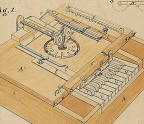Inventing the Future


In the Washington, DC, of 1862, Peter H. Watson’s powerful, hefty frame and red Amish-style beard made him instantly recognizable around the Department of War. Before being named assistant secretary of war, Watson had been a high-profile corporate patent lawyer. In 1854 he was employed as chief counsel for Rockford, Illinois-based J. H. Manny & Company, a maker of wheat-harvesting equipment. When rival Cyrus McCormick sued the Manny company over a patent on a reaper, Watson hired attorney and politician Edwin M. Stanton as his assistant. For additional support, Stanton contracted with an Illinois lawyer named Abraham Lincoln. Watson initially found Lincoln grating but came to admire the lanky fellow's skills. Watson advised Stanton to keep the tall attorney on retainer. These associations had repercussions. The connections linking railway barons, grain dealers, and the lawyers who represented them coalesced into the Republican Party. From California to Chicago, New York to Pennsylvania, many of the new party’s wealthiest supporters were merchants, railway men, and lawyers. Their collective power was undeniable.
Watson was ruthless. So that a client’s machine design would appear older than it actually was, he artificially aged a mechanical reaper's wooden components. He was arrogant. Meeting Abraham Lincoln in 1855, Watson derided the other man as a “railsplitter from the Wild West” before coming to recognize Lincoln’s gifts. Within a few years Lincoln was a president at war; to help prosecute that war, he recruited Watson to remove the taint of scandal from the War Department. Results of that hiring included a great expansion of the nation’s railroad systems, establishment of reliable supply lines to support Union general Ulysses Grant’s critical campaign in the west, and Watson’s most enduring legacy: creation of what became the futures market.

The War Department’s drafty offices crawled with spies working for either the Confederacy or some military contractor. All wanted to learn the size, disposition, and direction of Union forces—the enemy, to stop those forces; contractors, to gouge the army. To foil these agents, Watson often operated out of a railway car. He communicated most of his orders to his
You’re reading a preview, subscribe to read more.
Start your free 30 days





